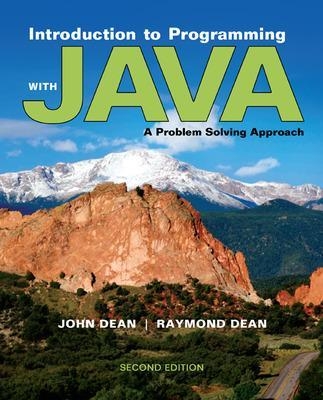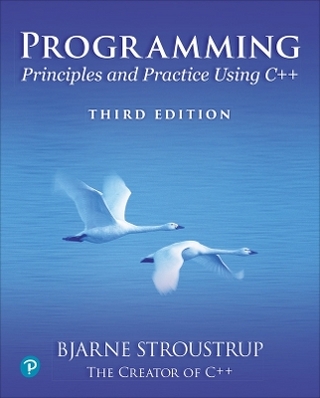
Introduction to Programming with Java: A Problem Solving Approach
McGraw Hill Higher Education (Verlag)
978-0-07-337606-6 (ISBN)
- Titel ist leider vergriffen;
keine Neuauflage - Artikel merken
Introduction to Programming with Java: A Problem Solving Approach teaches the reader how to write programs using Java. It does so with a unique approach that combines fundamentals first with objects early. The book transitions smoothly through a carefully selected set of procedural programming fundamentals to object-oriented fundamentals. During this early transition and beyond, the book emphasizes problem solving. For example, Chapter 2 is devoted to algorithm development, Chapter 8 is devoted to program design, and problem-solving sections appear throughout the book.The second edition adds new language features and end-of-chapter GUI sections that includeanimation. New chapters include an introduction to the Java Collections Framework andan in-depth treatment of recursion. Two new supplementary chapters on the book’s companion website describe the JavaFX GUI platform.Before diving into object-oriented programming (OOP) in Chapter 6, the second edition includesa “mini-chapter” that describes how to write multiple-method programs in a non-OOP environment. Those who want to continue this theme can follow an optional “late objects” approach by reading two chapters on the book’s website before returning to OOP in Chapter 6.Some key features include:•A conversational, easy-to-follow writing style.•Simple GUI programming early, in an optional standalone graphics track.•Well-identified alternatives for altering the book's sequence to fit individual needs.•Well-developed projects in six different academic disciplines, with a handy summary.•Detailed customizable PowerPointTM lecture slides, with icon-keyed hidden notes.I have used the Dean and Dean book in my Introduction to Java Programming class for the past year. This is an excellent text and I am very happy with it. It is the only text that I have ever usedthat always gets positive comments from students on my class evaluations even though there is no question asked about the text. The chapters are well thought out and the coverage is complete.The progression from topic-to-topic is masterful, and the writing is exceptionally clear and atthe perfect level for an introductory Java class.– Ralph Duffy, South Seattle Community College
John Dean is an Associate Professor in the Computer Science and Mathematics Department at Park University. He earned a Ph.D. degree in computer science from Nova Southeastern University and an M.S. degree in computer science from the University of Kansas. He is Java certified and has worked in industry as a software engineer and project manager, specializing in Java and various Web technologies— JavaScript, JavaServer Pages, and servlets. He has taught a full range of computer science courses, including Java programming and Java-based web programming. He has authored a web programming textbook with a focus on client-side technologies HTML5, CSS, and JavaScript. Raymond Dean is a Professor Emeritus, Electrical Engineering and Computer Science, University of Kansas. He earned an M.S. degree from MIT and a Ph.D. degree from Princeton University, and he is a senior member of IEEE. He has published numerous scientific papers and has 21 U.S. patents. He has industry experience in manufacturing HVAC equipment and energy-management controls, as well as in system energy analysis. At the University of Kansas, he taught a wide range of courses in electrical engineering and computer science.
Chapter 1. Introduction to Computers and ProgrammingChapter 2. Algorithms and DesignChapter 3. Java BasicsChapter 4. Control StatementsChapter 5. Using PreBuilt MethodsChapter 6. Object-Oriented ProgrammingChapter 7. Object-Oriented Programming-Additional DetailsChapter 8. Software EngineeringChapter 9. ArraysChapter 10. Arrays Lists and an INtroduction to the Java Collections FrameworkChapter 11. RecursionChapter 12. Type Details and Alternative Coding MechanismsChapter 13. Aggregation, Composition, and InheritanceChapter 14. Inheritance and PolymorphismChapter 15. Exception HandlingChapter 16. Files, Buffers, Channels, and PathsChapter 17. GUI Programming BasicsChapter 18. GUI Programming-Component Layout, Additional GUI Components
Appendix 1. ASCII Character SetAppendix 2. Operator PrecedenceAppendix 3. Java Reserved WordsAppendix 4. PackagesAppendix 5. Java Coding-Style ConventionsAppendix 6. Javadoc with TagsAppendix 7. UML DiagramsAppendix 8. Number Systems and Conversions Between Them
| Erscheint lt. Verlag | 16.3.2013 |
|---|---|
| Zusatzinfo | 199 Illustrations, unspecified |
| Verlagsort | London |
| Sprache | englisch |
| Maße | 188 x 231 mm |
| Gewicht | 1343 g |
| Themenwelt | Informatik ► Software Entwicklung ► Objektorientierung |
| Mathematik / Informatik ► Informatik ► Web / Internet | |
| ISBN-10 | 0-07-337606-X / 007337606X |
| ISBN-13 | 978-0-07-337606-6 / 9780073376066 |
| Zustand | Neuware |
| Haben Sie eine Frage zum Produkt? |
aus dem Bereich


